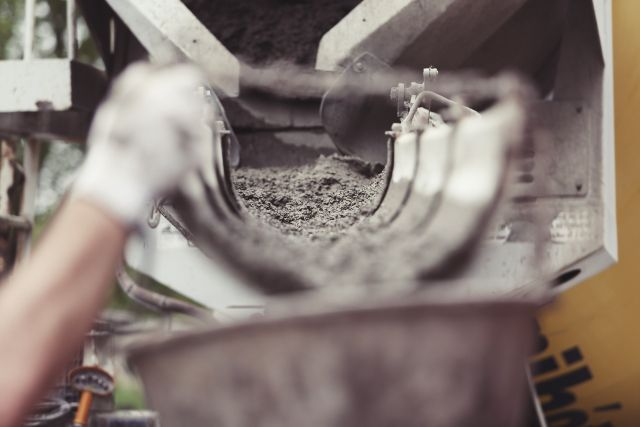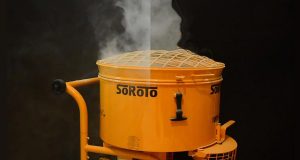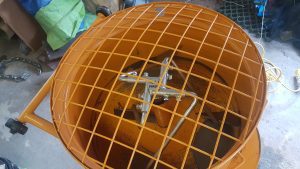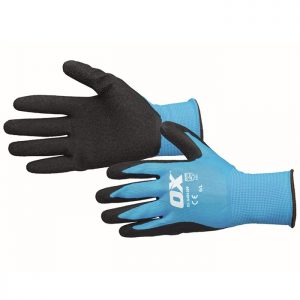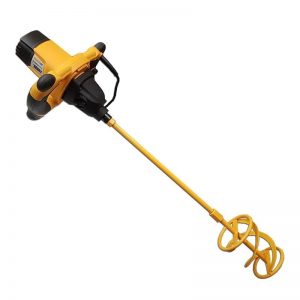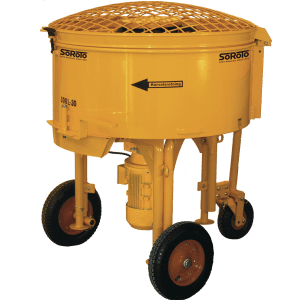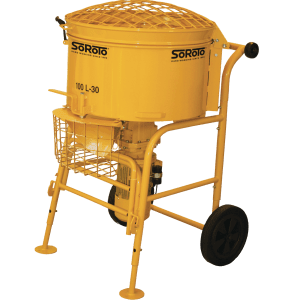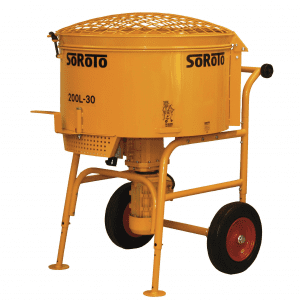advice for cement mixing using a forced action mixer
The accuracy of a cement mix depends on the durability of concrete.
Concrete is a building material which is a combination of cement, gravel and sand with water. It is vastly used in construction, so it is essential for professionals to understand the qualities of the material.
Cement mixing can take place in a forced action mixer. This blog post explains the strengths of concrete and five top tips for correctly mixing concrete.
What is concrete?
Concrete is easily and readily prepared in all shapes and structural systems.
It is simply a blend of aggregates, normally natural sand and gravel or crushed rock. These are bound together by a hydraulic binder and activated by water.
Concrete is very strong in resisting compression. It is the most widely used construction material in the world and allows flexibility in structural form as it can be moulded into a large number of shapes.
7 facts about concrete
- Concrete is the second most used material on earth after water.
- Concrete production contributes 5% of annual anthropogenic global CO2 production.
- Concrete in the middle of the Hoover Dam (opened in 1936) is still drying out.
- The largest ever, unreinforced concrete dome construction is the Pantheon in Rome which is more than 2000 years old.
- Cement, if sealed in a thermos flask with water, will reach boiling point.
- 99% of all ‘cracked’ concrete is associated with other construction factors and not the material as delivered.
- It is an extremely inexpensive material considering what it does. 1m3 of concrete equals 1000 litres of products. The same volume of paint, for example, would be a lot more expensive.
5 tips for correctly mixing concrete
Tip 1: Choose the best concrete mix ratio for general domestic jobs
The C20 concrete mix is a medium-strength concrete which is recommended for basic household constructions such as retention of posts, garden walkways and more.
For major structural adjustments or construction project, the architect, quality surveyor or building control officer should be able to recommend the concrete strength to be used.
The appropriate ratio for C20 includes the following:
- Cement – 1 part
- Sand (fine aggregate) – 2 parts
- Gravel (coarse aggregate) – 4 parts
Ideally, the water to be used should be 55% of the net weight of the cement if all other materials will be delivered absolutely dry. Often, however, the materials are usually damp thus the amount of water should be reduced.
Tip 2: Take precautions to ensure health and safety
Cement is not a good antidote for the human skin, thus protective clothing should be worn during manufacture.
At GCL Products we have a range of PPE equipment suitable for concrete mixing, including gloves.
Tip 3: Understand concrete mix strengths and types
Grades of concrete are defined by the strength and composition of the concrete, and the minimum strength the concrete should have following 28 days of initial construction.
The grade of concrete is understood in measurements of MPa, where M stands for mix and the MPa denotes the overall strength.
Concrete mixes are defined in ascending numbers of 5, starting at 10 and show the compressive strength of the concrete after 28 days. For instance, C10 has the strength of 10 newtons, C15 has the strength of 15 newtons, C20 has 20 newtons strength etc.
Different mixes (M) come in various mix proportions of the various ingredients of cement, sand and coarse aggregates. For instance, M20 comes in a ratio of 1:1:5:3.
Tip 4: Advice for mixing concrete using a paddle mixer
Mixing can be done manually using a paddle mixer or with machinery, such as a forced action mixer.
Using a paddle mixer to mix cement should only be done in instances where there is a small quantity.
First ensure surrounding surfaces are protected and use the correct ratios and precautions. Mix thoroughly until a uniform product is created.
Collect the mixture together in the centre of the work area and then scoop out the required amount of cement. Sprinkle around a third of the cement over the top of the pile and then mi b folding until cement is mixed thoroughly and then repeat the process another two times for the other two-thirds. Break up any lumps and ensure the material is evenly mixed with sand and aggregate.
Spread out the pile to make a hollow at the centre. The hollow area is to hold the water to be used. Only a third of the estimated water to be used should be added. Working around the heap, slowly scoop from the outer side of the mix into a hollow crater with water. Mix it well with the water by running it through with a hand trowel.
Make it into a pile again and add te second third of water and apply the instructions above. Add the remaining water, turning it inside out and continue until a “molten” mix is uniformly saturated with water.
Tip 5: Advice for mixing concrete using a forced action mixer
A mixer gives the best quality of mixes as it thoroughly churns the concrete to give a uniform product without stress.
Cover the area with a protective covering and position the forced action mixer in the middle of the area.
Start by filling with three-quarters of the water required for the concrete and then add half the quantity of gravel and sand. Add all the cement needed. Finally add the sand and gravel and leave the mixture to churn for half a minute before checking to see if the water is enough.When the concrete has mixed up satisfactorily, empty the content of the mixer into a wheelbarrow by tilting the drum of the mixer slowly.
Clean the mixer after use.
Types of concrete pan mixer
SoRoTo 40L: The 40L is a super portable mixer for contractors. It is able to mix up to 95kg of materials and is narrow, light and able to fit through standard doorways.
SoRoTo 80L: The 80L, designed for use on building sites, is abe to fit through most standard doorways. It features easy-load transportation rollers on the top of the machine, so loading into the back of a van or onto a pickup flatbed is simple and can be done by one person.
SoRoTo 100L: This mixer is ideally suited to contractors who have a requirement for mixing larger amounts (up to 240kg approximately) of materials. It is light and can be taken to where it is needed.
SoRoTo 120L: The 120L has a wide range of benefits, including adjustable front legs and a 120 litre mixing capacity, meaning it can be used for the larger and most awkward of jobs. It features specially designed mixer arms and a single phase 100v/1.1Kw motor delivering 30RPM to the machine which will ensure all day use.
SoRoTo 200L: With its specially selected 2.2kW motor, delivering 30RPM, the 200L performs fantastically well in almost all circumstances. Unlike other large pan mixers, this machine can be easily transported and used on a slanted and hard to reach areas due to its lightweight frame and adjustable legs. With a mixing capacity of 468g, service life of 20 ears and accessibility to be able to use the mixer on uneven surface, the 200L will save time and money.
SoRoTo 300L: The 300L is one of the largest mixers available on the market today. It is equipped with three detachable, robust wheels and an adjustable pole making it easy to transport around building sites. It also comes with three lifting rings to allow the mixer to be moved around by cranes on larger building sites.
Conclusion
Our mixers are perfect for mixing concrete, just as our forced action mixers are ideal for mixing a whole host of other materials – including resin bound gravel, plaster, render, screed, rubber mulch, lime mortar and much more.
Concrete is found all over the world. Concrete comes from cement which is utilised to bind other components together to make a number of robust building materials.
Read 5 steps to make mortar or concrete here.
Browse forced action mixers here. Alternatively, hire a forced action mixer here.
For more information call our helpful and friendly customer service team on 01246 418144.
Alternatively, contact us on webchat or email us here.

